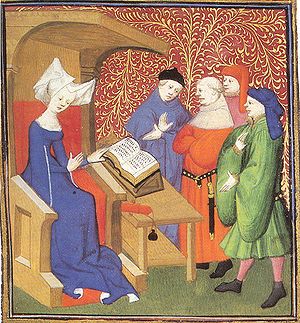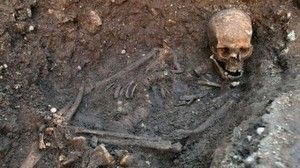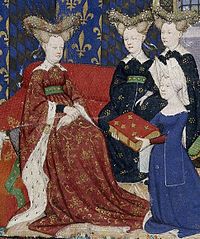Her name was Christine de Pizan or Cristina de Pisan (1363 – 1430) and she was the first European lady that successfully managed to be a professional writer. She was mainly known for her books of poetry but she also wrote a little known book on military strategy known as Deeds of Arms and of Chivalry composed around 1410.
 Cristine de Pizan lecturing men.
Cristine de Pizan lecturing men.
Her guiding lights for the composition of the book were Vegetius and John of Legnano. She lived at the French Court and it was there that the Earl of Oxford read her treatise and then applied her tactical counsels during the battle of Bosworth, fought on 22 August 1485 by King Richard III, the last of the Plantagenet, against the usurper – aided by French and several British traitors – Henry VII Tudor. That was the conclusion of the War of the Roses.
Oxford was so grateful to her that later commissioned to the printer William Caxton the publication of that book. The duke of Norfolk, commander of Richard III forces, launched his attack on the army of Henry VII, lead by Oxford, in the traditional way, splitting his forces in a left wing, right wing and centre. Oxford, following de Pizan’s advice, kept all his troops, mainly composed by French soldiers and knights, massed together to form sort of Roman squares. Richard III seeing that the situation was turning bad for him launched a direct attack on Henry, trying to kill him. He managed to kill his standard bearer but because of the intervention of the traitor Lord Stanley and his men, he bravely tried to rally his soldiers and pushed on his attack screaming : ‘Treason, treason, treason!’ and not ‘my kingdom for a horse!’ as Shakespeare wrote. Richard III was taken and killed.

These detail had been re examined and proven true after the discovery of the skeleton of Richard the III in 2012 under a car park, DNA testing with one of his descendant still living in Canada had confirmed the find, which had rekindled great interest on the subject. Richard III was painted as a deformed and wicked murderer and these rumours created a cracks in his credibility which were used by his Tudor successors – which had no dynastic rights to rule – to mount an invading expedition, the last in history, from France and seize supreme power in Great Britain. It was a process of defamation strikingly similar to that experienced by the Roman emperor Nero.
Christine de Pizan wrote 41 works during her long career. She married in 1380 at the age of 15, had three children and was a widow 10 years later. She spent most of her life at the Abbey of Poissy near Paris writing in Middle French. She challenged misogyny and stereotypes about women prevalent in the male-dominated medieval society.
She was the daughter of Tommaso di Benvenuto da Pizzano (originating from Pizzano, near Bologna) a cour astrologer, physician, councillor of the Republic of Venice. After the birth of his daughter he accepted an offer from the King of France, Charles V, as physician and alchemist and moved to Paris.

Christine de Pizan presents her book to Queen Isabeau of Bavaria.
Her most famous work was the The book of the city of Ladies and the Treasure of the City of Ladies. Her final work was an eulogy of Joan d’Arc.
For those interested to know more about her:
http://www.christinedepizan.net

I love this kind of historical and cultural openings. I didn’t know Cristina De Pizan, and I have to thank you.
I thought I had interiorized Italian literature and also medieval one, but I’m glad to discover you took me by surprise! And what interesting books she wrote. What about a translation of “Deeds of Arms and of Chivalry”? Or of “The book of the city of Ladies”?
Gratias tibi ago pro hac symbola. Vita et opera Christinae de Pazan, de quibus – pro pudor! – nihil antea sciebam, satis magni momenti esse videtur in historia societatis Europaeae. Nescio tamen cur factioni Eboracensi et Richardo ipsi tam studiose faveas!
Angelo, you are incredible finding such intriguing subjects that however are of interest to a worldwide audience. And I enjoy your writing flowing effortlessly, a pleasure to read.